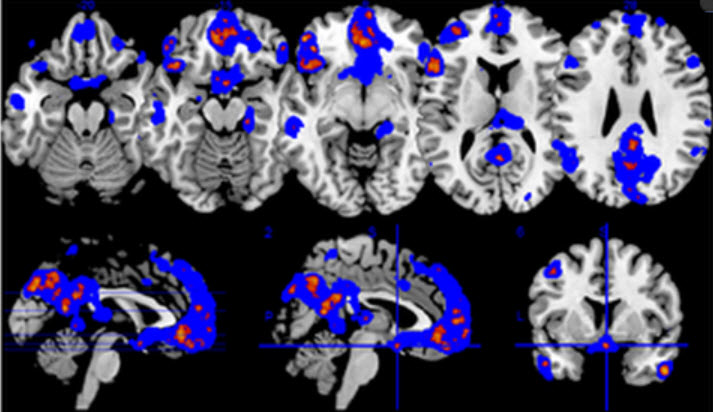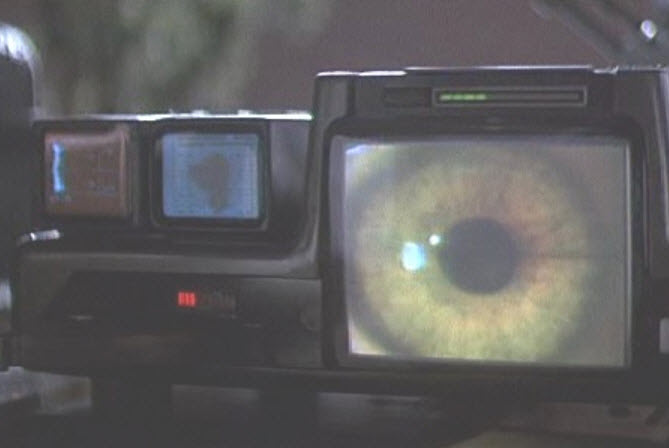A machine that trains you to feel affection
May 27, 2014

Affection detector: distributed voxel patterns that best distinguished between tenderness/affection vs. pride within the neurofeedback group, measured across all fMRI sessions. The color range shows voxels present in at least 40% (blue) or above 66% (red-yellow) of the subjects. (Credit: Jorge Moll et al./PLOS ONE)
It’s possible to create brain patterns associated with affection or tenderness toward loved ones, using neurofeedback while being scanned in a functional magnetic resonance (fMRI) machine, researchers at D’Or Institute for Research and Education (IDOR) in Brazil have shown.
The finding, described in PLOS ONE (open access), could open up new possibilities for treatment of conditions such as antisocial personality disorder, the researchers suggest.
An empathy detector
As the researchers note, in Ridley Scott’s film Blade Runner (loosely based on Philip K. Dick’s Do androids dream of electric sheep?), “blade runners” used an empathy-detection device called a Voight-Kampff machine to detect “replicants” (androids), who (in the movie) can’t feel affection.
The Blade Runner machine was similar to a polygraph, but IDOR researchers decided to use a more effective method. While lying in a functional magnetic resonance imaging (fMRI) machine, subjects were asked to think of memories of affection and pride while viewing a screen with a circle.
The researchers used pattern-detection algorithms called “support vector machines” to classify patterns in the participants’ brains (in the septohypothalamic area and frontopolar cortex, both linked to affectionate feelings in earlier research). When these patterns were detected, the circle would ripple and change shape. (It didn’t change for the control group.)
Pre-crime detection/retraining?
Might such a method be used in a future pre-crime* society to detect — and even retrain — psychopaths like Santa Barbara murder suspect Elliot Rodger?
Perhaps, but it’s still unknown how long the training effects last and whether they will work in other settings, Scientific American notes, adding that Ranganatha Sitaram, a neuroscientist at the University of Florida (unconnected to the study) has conducted similar neurofeedback studies and is cautiously optimistic about their practical promise. “Certainly this could be useful clinically,” Sitaram says. “But outside of the lab the effects of these types of techniques are hoped for but still not established.”
Lead author Jorge Moll agrees. “For now, this is pure research,” he told KurzweilAI in an email interview. “But these methods and strategies are on the verge of enabling studies looking at behavioral and clinical effects. Further research is needed before this can be used in the ‘real world,’ but I bet that could happen during the next five years or so.”
The study was supported by Foundation for Research Support and IDOR.
* In Philip K. Dick’s short story The Minority Report (and in the movie), “Precrime” is the name of a criminal justice agency tasked to identify and eliminate persons who will commit crimes in the future.
Abstract of PLOS ONE paper
In Ridley Scott’s film “Blade Runner,” empathy-detection devices are employed to measure affiliative emotions. Despite recent neurocomputational advances, it is unknown whether brain signatures of affiliative emotions, such as tenderness/affection, can be decoded and voluntarily modulated. Here, we employed multivariate voxel pattern analysis and real-time fMRI to address this question. We found that participants were able to use visual feedback based on decoded fMRI patterns as a neurofeedback signal to increase brain activation characteristic of tenderness/affection relative to pride, an equally complex control emotion. Such improvement was not observed in a control group performing the same fMRI task without neurofeedback. Furthermore, the neurofeedback-driven enhancement of tenderness/affection-related distributed patterns was associated with local fMRI responses in the septohypothalamic area and frontopolar cortex, regions previously implicated in affiliative emotion. This demonstrates that humans can voluntarily enhance brain signatures of tenderness/affection, unlocking new possibilities for promoting prosocial emotions and countering antisocial behavior.
